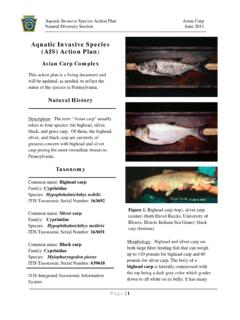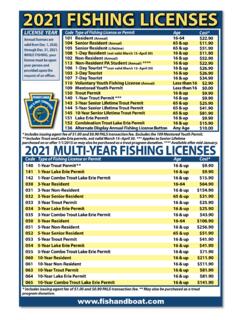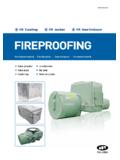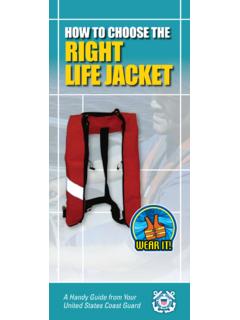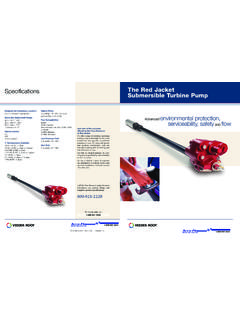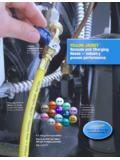Transcription of The Life Jacket Test — by Chris Edmonston …
1 Ife Jacket use, or more accu-rately, non-use, is arguably the number-one safety topic for federal and state boat-ing agencies. The Coast Guard s National Boating Safety Advisory Council is pushing toward requirements for adults to wear life jackets while on certain size boats or under certain conditions (See Time To Breathe New Life Into Life Jackets? Feb/Mar 2011).When asked why they don t wear life jackets, two of the biggest factors boaters mention are the cost and lack of comfort of current USCG-approved life jackets. To its credit, the National Boating Safety Advisory Council has recognized these factors as be-ing impediments to life Jacket wear in their latest strategic plan (available at ). The Council recommends a wider array of life jackets be approved, and also recom-mends the adoption of the Interna-tional Stan-dards Or-ganization s (ISO) level 50 devices, a standard used in Eu-rope.
2 These are characterized as buoy-ancy aids by the ISO, and don t have the flotation necessary to be USCG-approved under the current standards. Yet you d be hard pressed to tell the difference among many of these devices and the jackets that are Coast Guard approved. The Foundation conducted tests to find out the differences, if any, be-tween USCG-approved jackets and jack-ets that meet the ISO standards, as well as a few jackets that weren t approved by anyone. We used traditional Coast Guard Type I, II, and III jackets as controls, and then examined a number of different styles of jackets, including: vest- or suspender-style inflatable jackets, jackets designed for paddling, fishing, sailing, watersports, and even jackets that look more like regular clothing. Though many models were not made to meet USCG standards, we incorporated many of the tests used by Underwriters The Life Jacket Test by Chris Edmonston56 | Magazine june | j u ly 2 011 LOur testers discerned the differences be-tween competing life Jacket standards by getting in the water and using themSailing JacketS Dinghy sailors have been driving demand for low-profile, form-fitting jackets made for racing.
3 As a result, there were more jackets, six in total, to test in this category than any other: the Stohlquist Kitty, the Baltic Dinghy Pro, the Zhik PFD, the Spinlock Zero, the Gill Compressor, and the Gill Pro Racer. The Zhik was the hands-down winner in this category, worn here by Rubenia Recinos from the Marine Insurance Division. Testers noted the ease of putting it on, as well as the fit both in and out of the water. It also didn t ride up, and it was easier to swim with this Jacket than many others. WaterSportS JacketS Watersports enthusiasts are branching off from traditional Type III jackets, prefering models designed for sports, such as wakeboarding and the use of personal watercraft. Five jackets were tested: the yamaha Ski Pro, the O neill law, the O neill Outlaw, the liquid Force Car-digan, and the Baltic Rekord. The Cardigan and the Outlaw, as the names imply, are not approved by any standard. The law and the Ski Pro jackets both performed best, with Ski Pro getting the nod as the staff favorite.
4 One tester called the Ski Pro Jacket perfect. The Ski Pro, worn here by Mau-rice Weir from the Telecommunications Department, is built most closely to a standard life Jacket . The law is a pullover vest that feels closer to a neoprene wetsuit, which could get uncomfortable on a hot JacketS Four jackets were test-ed that are marketed to paddlers: the West Marine Medalist, the Kokatat Hybrid Inflat-able, the Baltic Canoe, and the Stearns nova Paddle. The Kokatat Hybrid, worn here by linda Viphongsay from the Marine Insurance Division, was the staff pick; it was slightly more comfortable than the others, and provided more buoyancy due to the addition of a manually inflated air bladder.(Continued on page 58)Foundation Findings #50 The Life Jacket Test by Chris Edmonstonjune | j u lY 2 011 Magazine | 57 Vest-style Inflatable Jackets We tested four different vest-style inflatables: the Mustang deluxe au-tomatic, the Spinlock Deck Vest, the Secumar, and the Baltic Winner.
5 The Mustang, worn here by emily Tierney from the Cooperating Marina Department, combined the best overall fit both in and out of the water, ease of donning, and performance in the Jackets More people die while fishing than during any other recreational boat-ing activity. Getting anglers in life jackets has been a goal of the Foundation and the Coast Guard for the last decade. We took a look at four jackets designed for anglers: the Onyx Classic, the Stormy Seas Inflatable expedition, the Baltic Fisherman, and the Stearns Sports Vest. The Onyx and Stearns jackets are built along traditional Type III lines, with a few extra features for anglers. They both tested well, with the staff choice being the Onyx Jacket , worn by Andrew Steenbuck from the Internet Operations Department. The Stormy Seas Jacket was by far the most comfortable on land, but didn t perform well in the water. Testers had to work harder to stay upright in the water, and felt that it would slide off.
6 Float coats We also tested jackets that look more like outerwear than life jackets. This style of Jacket has great potential for use, particularly in colder weather. We looked at two foam jackets, the Stearns Float Coat, and the Baltic Surf and Turf. We also looked at three inflatable jackets, all from Stormy Seas: the newport, the Sweater, and the north Pacific. The Baltic vest was the clear winner in this category, with all of the female testers (it s a ladies Jacket ) wanting to take it home. Worn here by elise Fullford from our Tow-ing Services Division, it is stylish, comfortable on land, and more comfortable than other jackets while floating. traditional Uscg JacketsKent Offshore Type I 14 Kent near shore Type II 16 Kent General Purpose Type III 13 Vest-style Inflatable JacketsMustang Auto 24 Spinlock Deck Vest 21 Secumar 23 Baltic Winner 23 Paddling JacketsWest Marine Medalist 27 Kokatat Hybrid 28 Baltic Canoe 19 Stearns nova Paddle 21sailing JacketsStohlquist Kitty 24 Baltic Dinghy Pro 23 Zhik 27 Spinlock Zero 21 Gill Compressor 19 Gill Pro Racer 19 Watersports JacketsYamaha Ski Pro 25O neill law 24liquid Force 23 Baltic Rekord 22float coatsStearns Float Coat 25 Stormy Seas newport 25 Stormy Seas Sweater 25 Stormy Seas north Pacific 24 Baltic Surf and Turf 26fishing JacketsOnyx Classic 26 Stormy Seas expedition 24 Baltic Fisherman 25 Stearns Sports Vest 25 ApprovAlType of jAckeTScore(out of 30)
7 Key =Uscg =Iso =none=#1 in typesPecIalsafetyIt Can t Save You If You Won t Wear ItThe scores are a combination of performance mea-surements such as freeboard and face-angle, and test subject s opinion on comfort, fit and other test crite-ria. For more information and in-depth scores., visit , which tests life jackets for the Coast Guard. We tested for freeboard and face angle in the water. We looked to see if jackets would roll people face-up. We had testers jump in the water to see if the jack-ets would come off, and then looked at how hard it was for them to swim. We looked at comfort both in and out of the water, and ease of putting the Jacket on while out of the water. Testing was conducted in a pool, so no rough-water performance assess-ments were made. In order to minimize any potential bias, test subjects were not told which jackets were USCG approved.
8 Some of the jackets tested are not sold in the Overall, many of the ISO-approved jackets performed in a similar fashion to the USCG-approved jackets. After all the tests were completed, it was evident that there is a difference in performance between jackets built to USCG standards and jackets that aren t. Keep in mind that the ISO Level 50 standards were specifically designed as buoyancy aids as opposed to life jackets, and the written standard (ISO 12402 Part 5) states that these devices are designed to provide the kinds of flotation (inherently buoyant foam, hybrid, and inflatable) that will accommodate the sometimes conflict-ing needs of reliability and durability, in-58 | Magazine june | j u ly 2 011water performance, and continuous wear.
9 The ISO recognizes that while people should have the option to choose a Jacket best suited for the conditions on the water, when buying a Jacket it s the boater s re-sponsibility to take into account how the Jacket will perform in the potential water conditions. For complete test details, visit in the , there have been at-tempts to educate boaters on which life Jacket to use based on activity, but the USCG standards are geared more toward performance measurements ( , how high does the Jacket keep you out of the water), not the intended activity. The unintended consequence of this is that boaters have life jackets aboard that perform well in an emergency, but they aren t jackets that boaters will wear. A life Jacket that isn t worn isn t effective. With the current push by the Coast Guard s Advisory Council to enact mandatory life Jacket use, one way to increase use would be to create a buoyan-cy aid category in the USCG standards or to adopt the ISO Level 50 standards, which would increase the variety of jackets on the market.
10 Some may say, correctly, that these jackets don t perform as well as those cur-rently approved by the Coast Guard. But the reality is that most people who drown never intended to be in the water, and most likely didn t have the opportunity to put a life Jacket on after getting in the wa-ter. Clearly, the best life Jacket is one that is worn, which seems to be behind the ra-tionale of the ISO for having a buoyancy aid category it provides the option of putting on and wearing a comfortable Jacket that is suitable for the given condi-tions, which is deemed to be better than not wearing one at all. As the Coast Guard moves toward approving similar devices, the Foundation will report on develop-ments in the approval process and on new jackets entering the New W Sis the fastest wayto make strong, lasting, waterproof repairs with epoxy. The dual-chambered, self-metering cartridge fits into any standard caulking static mixer delivers fully mixed, thickened W Sepoxyin the amount you need for the job at hand.





